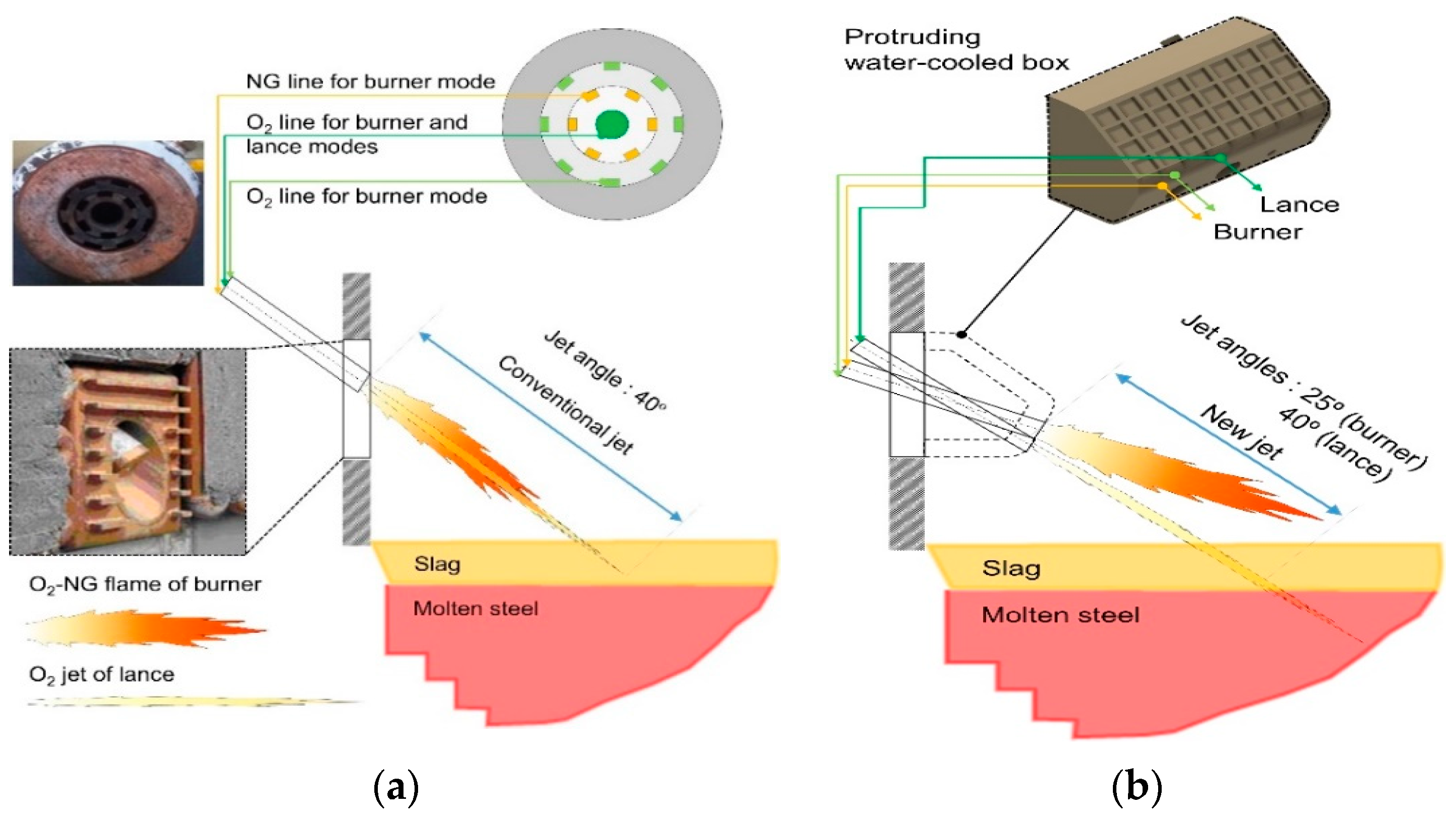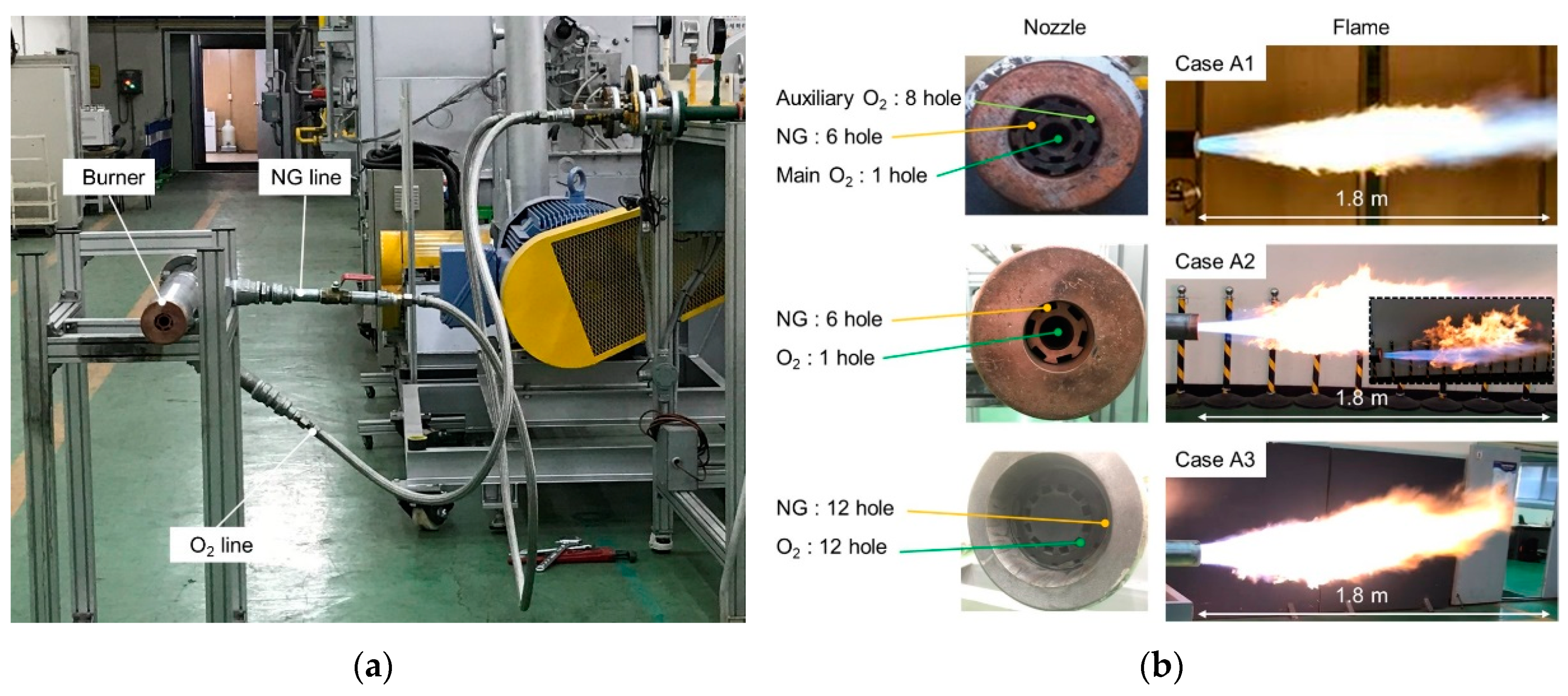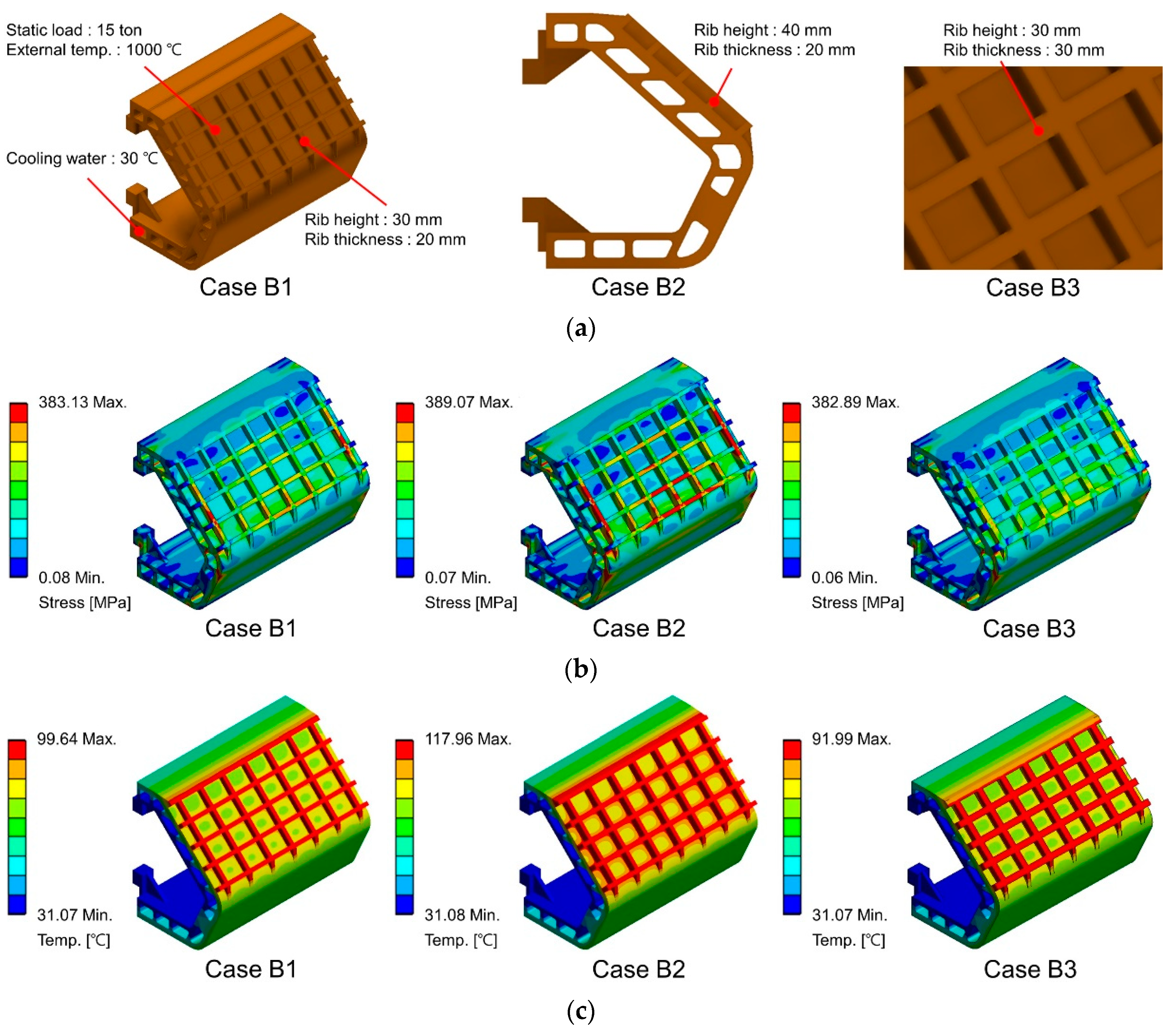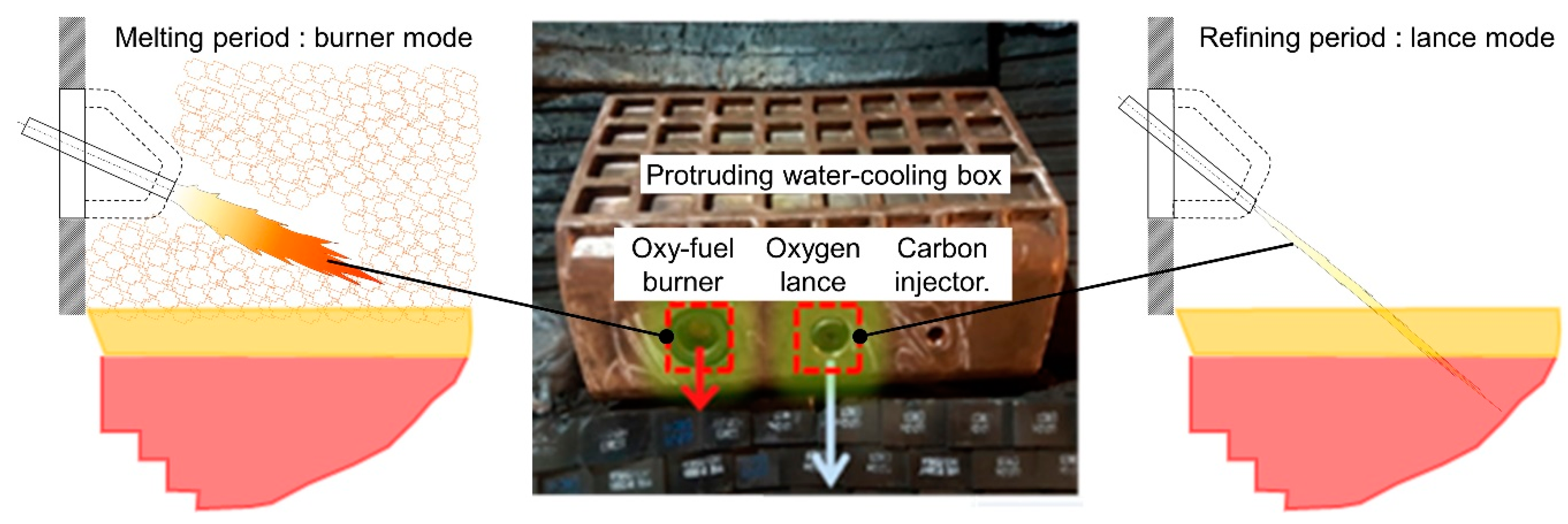Improvement of Energy Efficiency and Productivity in an Electric Arc Furnace through the Modification of Side-Wall Injector Systems
Abstract
1. Introduction
2. Materials and Methods
2.1. Modification Concept of Side-Wall Injector System For Improving Energy Efficiency and Productivity in the EAF
2.2. Flame Test of the Oxy-Fuel Burner and Thermal/Mechanical Analysis of Protruding Water-Cooled Copper Jacket for the Side-Wall Injector System
2.3. Evaluation of EAF Performance Before and After System Modification
3. Results and Discussion
3.1. Flame Characteristics of the Developed Oxy-Fuel Burner
3.2. Thermal and Mechanical Characteristics of the Developed Protruding Water-Cooled Copper Jacket
3.3. Improvement of EAF Performance Before and After System Modification
4. Conclusions
Author Contributions
Funding
Conflicts of Interest
References
- Kovačič, M.; Stopar, K.; Vertnik, R.; Šarler, B. Comprehensive electric arc furnace electric energy consumption modeling: A pilot study. Energies 2019, 12, 2142. [Google Scholar] [CrossRef]
- Lee, B.; Sohn, I. Review of innovative energy savings technology for the electric arc furnace. JOM 2014, 66, 1581–1594. [Google Scholar] [CrossRef]
- Carpenter, A.M. CO2 Abatement in the Iron and Steel Industry; IEA Clean Coal Centre: London, UK, 2012. [Google Scholar]
- Tang, G.; Chen, Y.; Silaen, A.K.; Krotov, Y.; Riley, M.F.; Zhou, C.Q. Effects of fuel input on coherent jet length at various ambient temperatures. Appl. Therm. Eng. 2019, 153, 513–523. [Google Scholar] [CrossRef]
- The Japan Iron and Steel Federation. The State-of-the-Art Clean Technologies (SOACT) for Steelmaking Handbook, 2nd ed.; Available online: https://www.jisf.or.jp/business/ondanka/eco/docs/SOACT-Handbook-2nd-Edition.pdf (accessed on 12 September 2020).
- Nardin, G.; Meneghetti, A.; Magro, F.D.; Benedetti, N. PCM-based energy recovery from electric arc furnaces. Appl. Energy 2014, 136, 947–955. [Google Scholar] [CrossRef]
- Pardo, N.; Moya, J.A. Prospective scenarios on energy efficiency and CO2 emissions in the European iron & steel industry. Energy 2013, 54, 113–128. [Google Scholar]
- Brhel, J.; Farmer, C.; Shver, V. The JetBOxTM burner/injector system for EAF steelmaking. Millenn. Steel 2006, 87–97. [Google Scholar]
- Elkoumy, M.M.; El-Anwar, M.; Fathy, A.M.; Megahed, G.M.; El-Mahallawi, I.; Ahmed, H. Simulation of EAF refining stage. Ain Shams Eng. J. 2018, 9, 2781–2793. [Google Scholar] [CrossRef]
- Opfermann, A.; Goekce, F.; Libera, K.; Grosse, A. The LM.3—The new era of efficient energy input optimization in the EAF. Metall. Ital. 2016, 5–15. Available online: http://www.aimnet.it/la_metallurgia_italiana/2017/febbraio/Opfermann.pdf (accessed on 12 September 2020).
- Industrial Gas Prices in the IEA (QEP 5.7.1); Department of Energy and Climate Change: UK, 2020. Available online: https://www.gov.uk/government/statistical-data-sets/international-industrial-energy-prices (accessed on 12 September 2020).
- Industrial Electricity Prices in the IEA (QEP 5.3.1); Department of Energy and Climate Change: UK, 2020. Available online: https://www.gov.uk/government/statistical-data-sets/international-industrial-energy-prices (accessed on 12 September 2020).
- Worrell, E.; Price, L.; Martin, N. Energy efficiency and carbon dioxide emissions reduction opportunities in the US iron and steel sector. Energy 2001, 26, 513–536. [Google Scholar] [CrossRef]
- He, K.; Wang, L. A review of energy use and energy-efficient technologies for the iron and steel industry. Renew. Sustain. Energy Rev. 2017, 70, 1022–1039. [Google Scholar] [CrossRef]
- Pretorius, E.; Oltmann, H.; Jones, J. EAF Fundamentals; LWB Refractories: New York, NY, USA.
- Megahed, G.M.; Fathy, A.M.; Morsy, M.A.; Adbelaziz, E.A. Improving EAF performance by chemical energy optimisation at Ezz flat steel. Ironmak. Steelmak. 2010, 37, 445–451. [Google Scholar] [CrossRef]
- Thomson, M.J.; Kournetas, N.G.; Evenson, E.; Sommerville, I.D.; McLean, A.; Guerard, J. Effect of oxyfuel burner ratio changes on energy efficiency in electric arc furnace at Co-steel Lasco. Ironmak. Steelmak. 2001, 28, 266–272. [Google Scholar] [CrossRef]
- Memoli, F.; Mapelli, C.; Ravanelli, P.; Corbella, M. Evaluation of the energy developed by a multipoint side-wall burner-injection system during the refining period in a EAF. ISIJ Int. 2004, 44, 1511–1516. [Google Scholar] [CrossRef][Green Version]
- Cantacuzene, S.; Grant, M.; Boussard, P.; Devaux, M.; Carreno, R.; Laurence, O.; Dworatzek, C. Advanced EAF oxygen usage at Saint-Saulve steelworks. Ironmak. Steelmak. 2005, 32, 203–207. [Google Scholar] [CrossRef]
- Kirschen, M.; Risonarta, V.; Pfeifer, H. Energy efficiency and the influence of gas burners to the energy related carbon dioxide emissions of electric arc furnaces in steel industry. Energy 2009, 34, 1065–1072. [Google Scholar] [CrossRef]







| Country | NG (Cent/kWh) | Electricity (Cent/kWh) | Electricity/NG (-) |
|---|---|---|---|
| Canada | 1.05 | 8.24 | 7.86 |
| USA | 1.36 | 6.81 | 5 |
| Germany | 3.03 | 14.28 | 4.72 |
| United Kingdom | 2.99 | 13.66 | 4.57 |
| Italy | 3.88 | 17.12 | 4.57 |
| Belgium | 3.10 | 13.41 | 4.32 |
| Spain | 2.96 | 12.52 | 4.23 |
| Slovakia | 3.38 | 13.87 | 4.10 |
| Portugal | 3.29 | 13.28 | 4.04 |
| Turkey | 1.97 | 6.98 | 3.55 |
| Japan | 4.52 | 15.79 | 3.49 |
| Poland | 2.96 | 9.39 | 3.17 |
| Ireland | 4.10 | 12.63 | 3.08 |
| Netherlands | 2.97 | 9.13 | 3.07 |
| Hungary | 3.09 | 9.26 | 3.00 |
| Czech Republic | 3.17 | 9.47 | 2.99 |
| Austria | 3.69 | 10.83 | 2.93 |
| Greece | 3.55 | 10.26 | 2.89 |
| France | 4.28 | 11.42 | 2.67 |
| Luxembourg | 3.25 | 8.20 | 2.52 |
| Korea | 4.24 | 9.85 | 2.32 |
| Denmark | 4.11 | 9.13 | 2.22 |
| Switzerland | 7.27 | 11.99 | 1.66 |
| Finland | 5.27 | 7.70 | 1.46 |
| Sweden | 4.93 | 6.85 | 1.39 |
| Mean values | 3.53 | 10.88 | 3.43 |
| Max. values | 7.22 | 17.12 | 7.86 |
| Min. values | 1.05 | 6.81 | 1.39 |
| Item | Before | After | Difference | Cost [USD/t] |
|---|---|---|---|---|
| Production [t] | 37,945 | 19,437 | ||
| Charge number during the test (time, day) | 304 (17) | 155 (9) | ||
| Electrical consumption [kWh/t] | 396.2 | 391.2 | -5 | -0.41 |
| Oxygen consumption [Nm3/t] | 18.8 | 21.3 | +2.5 | +0.2 |
| Natural gas consumption [Nm3/t] | 0.2 | 0.4 | +0.2 | +0.072 |
| Carbon consumption [kg/t] | 11.4 | 10.3 | -1.1 | -0.16 |
| Power-on time [min] | 49.2 | 48.4 | -0.8 | |
| Tap-to-tap time [min] | 62.4 | 61.1 | -1.3 | |
| Productivity [t/h] | 120 | 123.1 | +3.1 | |
| Total energy cost savings [USD/t] | 0.298 | |||
| Annual production [t/yr] | 774,908 | |||
| Annual cost savings [USD/yr] | 224,329 | |||
© 2020 by the authors. Licensee MDPI, Basel, Switzerland. This article is an open access article distributed under the terms and conditions of the Creative Commons Attribution (CC BY) license (http://creativecommons.org/licenses/by/4.0/).
Share and Cite
Sung, Y.; Lee, S.; Han, K.; Koo, J.; Lee, S.; Jang, D.; Oh, C.; Jang, B. Improvement of Energy Efficiency and Productivity in an Electric Arc Furnace through the Modification of Side-Wall Injector Systems. Processes 2020, 8, 1202. https://doi.org/10.3390/pr8101202
Sung Y, Lee S, Han K, Koo J, Lee S, Jang D, Oh C, Jang B. Improvement of Energy Efficiency and Productivity in an Electric Arc Furnace through the Modification of Side-Wall Injector Systems. Processes. 2020; 8(10):1202. https://doi.org/10.3390/pr8101202
Chicago/Turabian StyleSung, Yonmo, Sangyoun Lee, Kyungmoon Han, Jaduck Koo, Seongjae Lee, Doyoung Jang, Changyong Oh, and Byunghwa Jang. 2020. "Improvement of Energy Efficiency and Productivity in an Electric Arc Furnace through the Modification of Side-Wall Injector Systems" Processes 8, no. 10: 1202. https://doi.org/10.3390/pr8101202
APA StyleSung, Y., Lee, S., Han, K., Koo, J., Lee, S., Jang, D., Oh, C., & Jang, B. (2020). Improvement of Energy Efficiency and Productivity in an Electric Arc Furnace through the Modification of Side-Wall Injector Systems. Processes, 8(10), 1202. https://doi.org/10.3390/pr8101202






